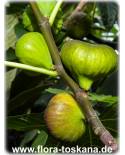Ficus carica - Common Fig Tree (Green Fig)
A Common Fig Tree (Ficus carica) in the garden or conservatory or in a pot on the balcony or terrace makes the dream of the Mediterranean oasis at home just perfect. Figs with green skin are in no way inferior in taste to the ones with purple skin. On the contrary, depending on the variety, figs with green skin are larger and more numerous.
Varieties (green figs):![]() 'Dottato: pear-shaped fruits of medium size with yellow flesh and intense aroma; ripening: September/October; another, early harvest with also medium sized fruits is possible in July, but often does not happen in our country; growth: moderate & quite compact
'Dottato: pear-shaped fruits of medium size with yellow flesh and intense aroma; ripening: September/October; another, early harvest with also medium sized fruits is possible in July, but often does not happen in our country; growth: moderate & quite compact![]() 'Columbaro Bianco': green-fruited with light pink, very aromatic and sweet flesh; ripening: September/October; habit: vigorous & slender
'Columbaro Bianco': green-fruited with light pink, very aromatic and sweet flesh; ripening: September/October; habit: vigorous & slender![]() 'Brogiotto Bianco': green-skinned, medium sized and roundish fruits with intense, sweet taste; Ripening: September/October; Growth: vigorous
'Brogiotto Bianco': green-skinned, medium sized and roundish fruits with intense, sweet taste; Ripening: September/October; Growth: vigorous![]() 'Filacciano: round to slightly pear-shaped, medium-sized fruits with delicious aroma; Ripening: August/September; Growth: vigorous
'Filacciano: round to slightly pear-shaped, medium-sized fruits with delicious aroma; Ripening: August/September; Growth: vigorous![]() General information on green-fruited fig trees: The answer to the most frequent question in advance: green figs taste just as sweet and aromatic as purple ones. Only our eyes make a difference, implying that red fruits always taste better than green ones because they signal "ripeness" to us. All other characteristics of green and purple figs are the same: their leaves are deeply lobed and aromatic, their growth and branches are vigorous, and their bark is attractively light gray and smooth. Since figs are hardy and leafless in winter, they are very easy to overwinter indoors in unheated areas with low light. Or they can be planted in the garden, where they have a naturally high frost resistance, which can be increased by a simple winter protection of fleece or bamboo mats (no plastic foil!!) (for more information see description at "Purple figs"). In average summers, all green and purple fig varieties will ripen by fall if they have full sun and are always well watered. Drought results in small, sapless "fruit dummies." If an early fall temperature drop threatens to stop fruit ripening, it is advisable to place the plants sheltered near the house or bring them indoors in time for the figs to ripen, which they do quickly in bright, warm places.
General information on green-fruited fig trees: The answer to the most frequent question in advance: green figs taste just as sweet and aromatic as purple ones. Only our eyes make a difference, implying that red fruits always taste better than green ones because they signal "ripeness" to us. All other characteristics of green and purple figs are the same: their leaves are deeply lobed and aromatic, their growth and branches are vigorous, and their bark is attractively light gray and smooth. Since figs are hardy and leafless in winter, they are very easy to overwinter indoors in unheated areas with low light. Or they can be planted in the garden, where they have a naturally high frost resistance, which can be increased by a simple winter protection of fleece or bamboo mats (no plastic foil!!) (for more information see description at "Purple figs"). In average summers, all green and purple fig varieties will ripen by fall if they have full sun and are always well watered. Drought results in small, sapless "fruit dummies." If an early fall temperature drop threatens to stop fruit ripening, it is advisable to place the plants sheltered near the house or bring them indoors in time for the figs to ripen, which they do quickly in bright, warm places.![]() Quality: delicious fruit even on very young plants; fruit set without pollination; abundant annual harvest; attractive plants with hand-shaped & aromatic leaves; easy to overwinter
Quality: delicious fruit even on very young plants; fruit set without pollination; abundant annual harvest; attractive plants with hand-shaped & aromatic leaves; easy to overwinter![]() Use: from April in containers on balcony & terrace or in the garden; planted out in the garden; year-round in an unheated conservatory
Use: from April in containers on balcony & terrace or in the garden; planted out in the garden; year-round in an unheated conservatory
Data sheet
- Family
- Moraceae
- Origin
- Mediterranean
- Fruits
- Edible fruits
- Growth
- Tree
- Location
- Sunny
- winter temperature
- 5 (+/- 5) °C
- Minimum temperature
- -15 °C
- Hardiness Zones
- 7
- Height
- 3 - 4 m
You might also like
Customers who bought this product also bought:









































